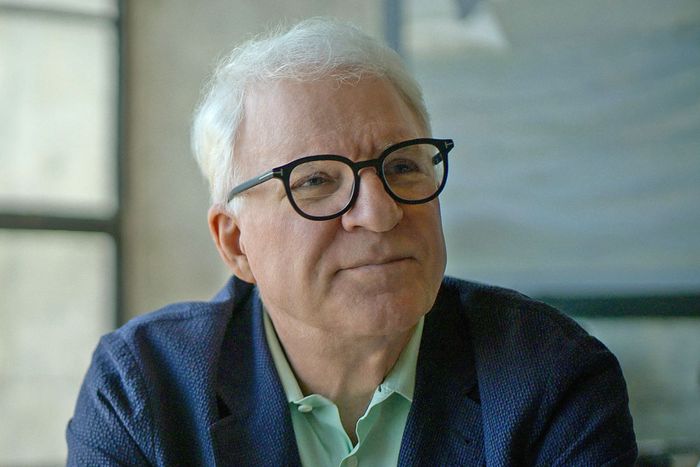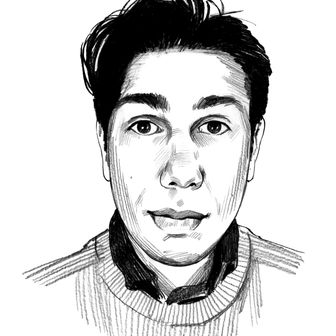
Steve! (Martin) a documentary in 2 pieces, the new documentary about the titular comedy legend on Apple TV+, is, as its title indicates, split into two episodes (Then and Now), each roughly 90 minutes in length. Near the beginning of the latter chapter (Now), the documentary cuts between interview snippets with six of Martin’s friends and collaborators talking about how much of an enigma he is. “He was always closed off and wouldn’t talk to people,” says director Frank Oz. “I still wouldn’t be able to say, like, ‘Well the real Steve …’” says frequent co-star Tina Fey. Then it complicates this narrative with a curveball. “Steve has changed more than any other person I know,” says writer and friend Adam Gopnik. Where Steve! is most successful is in highlighting the depth of this transformation. “How did I go from riddled with anxiety in my 30s to 75 and really happy?” he asks. But as much as director Morgan Neville demonstrates this shift through standard documentary tools like interviews and collage, he also does so formally — by moving from a stiff, claustrophobic filmmaking style in its first part (Then) to a shaggier style in the second.
Neville, an Emmy-winning and Oscar-nominated documentarian with a reputation for well-made meat-and-potato biodocs like 2018’s Won’t You Be My Neighbor?, directs Then with a bit of distance. Consisting entirely of archival footage and a mix of interview and archival audio, it traces Martin’s rise from childhood magic enthusiast to superstar comedian, focusing closely on his emotionally cold home life, comedy philosophies, and all-consuming anxieties about translating his style to audiences. It’s fascinating for fans of Martin and stand-up history — less on the basis of its revelatory content than its well-curated clips of Martin’s material and his discussions about the process of writing it. But it also plays, at times, like a third-party adaptation of Martin’s classic 2007 memoir, Born Standing Up; at least one review has noted that some of Martin’s audio within the documentary may well be pulled from the recording of its audiobook. Using flashes of his journal entries and personal correspondence, it paints a picture of Martin as a performer tortured by his art, more able to fixate on setbacks than he is to celebrate wins, even as he’s increasingly isolated by his unprecedented success. And because the audience only hears Martin and never sees him (or anyone else, for that matter) speak in present day, it mimics the feeling of being trapped in Martin’s head. By the time it’s over, it’s not necessary to question why Martin felt compelled to quit stand-up at the height of his draw in 1980 — it’s palpable.
Now, by contrast, opens on a scene of present-day Martin seemingly at his most relaxed, going through his morning routine of making poached eggs. It spends time documenting his work post-stand-up — his movie career, banjo success, cartooning, playwriting, and art-collecting — but it’s less interested in chronicling any of these pursuits individually than in his personal growth outside them. It does so by affecting a chummier feel, closer in tone to the documentaries about comedians like Albert Brooks and Garry Shandling that have populated the airwaves in recent years. Martin acts as a willing tour guide through his life, talking about things like fatherhood’s transformative effects and trying on his old Three Amigos costume (it still fits); there are sit-down interviews with people like Martin’s wife, Anne Stringfield; and Neville’s voice is often audible from off-camera, making the story feel more like a discussion than a monologue. “Do you have a melancholy inside you?” Martin asks Jerry Seinfeld in conversation at one point. “Quite often,” Seinfeld replies. “Yeah, me too,” continues Martin. “But that’s dissipated. I had more melancholy younger.”
Now is at its best in the scenes that feature Martin Short, most of which are cleverly shot like excerpts from a reality-TV show. The pair sit across from each other and workshop material for their double act, go for joint bike rides, and roast each other in casual conversation. In these slice-of-life moments, the documentary offers a glimpse at Martin at his most open and collaborative, a far cry from the guarded version of himself on display in Then. “As you get older, you either become your worst self or your best self,” Martin pontificates to Short at one point. “I’ve become nicer, kinder, more open.” Short agrees: “Yeah, because for about 50 years there, you were a real prick.”
There’s a moment at the beginning of Now when the heavy neuroticism of Then trickles in. Martin, sitting in front of a cassette player, is attempting to listen to an early stand-up performance he’d taped, and he finds himself unable to get through it. “We should listen to the end to see where it went, but I just can’t bear it,” he says, as he ejects the tape. “I have a whole new life now.” Not long after, this exercise is interrupted by an impromptu phone call from Short. The documentary never returns to the tapes again.


